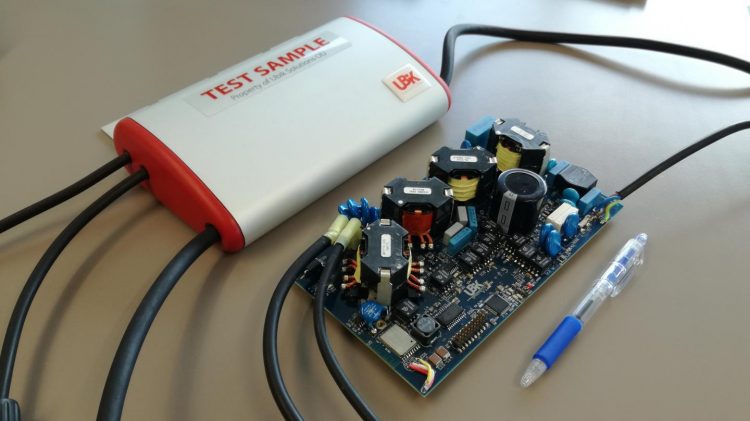The new technology will significantly enhance energy harvest from PV modules

Optiverter, photo by Dmitri Vinnikov. Credit: Dmitri Vinnikov
The TalTech Power Electronics Research Group led by Researcher-Professor Dmitri Vinnikov has been working on improvement of the efficiency of alternative energy generation units for over decade.
“In the early years of the alternative energy deployment, it was outrageously expensive for an ordinary consumer, but the developments in recent years, the triumph of materials technology and the efforts of power electronics engineers have made the price much more affordable for the consumers,” Professor Vinnikov says.
The research group led by Dmitri Vinnikov is focusing on the research on solar photovoltaic energy production. Under ideal conditions, any photovoltaic system (solar power plant) would supply consumers with electricity without any problems. Unfortunately, at our latitude there are no ideal operating conditions for PV modules. The environmental and natural factors that affect the performance of such systems most are (apart from Nordic sunlight) deposition of dirt (snow, soil, leaves) on PV module surfaces and long shadows created by lower sun angle affect.
“In order to convert energy, which comes from the renewable energy sources, into electricity for the consumers, a grid converter must be used, which transforms the output of the renewable energy source into a current suitable for home appliances. In addition to a converter, a special devices called power optimizer must be used to maximize energy harvest so that it would not be influenced by weather and would provide maximum benefit for the consumer,” Dmitri Vinnikov explains.
The power electronics researchers of Tallinn University of Technology have taken a step further to solve this problem – they have developed a hybrid technology Optiverter? that combines the key advantages of photovoltaic power optimizers and grid converters. It is a novel power semiconductor converter technology used in the power systems of small and medium-sized PV installations, and possibly for building integrated PV.
The first prototype of the Optiverter? was created already in 2016. After three years of comprehensive R&D activities the research group is planning, in cooperation with the Estonian company Ubik Solutions OÜ, to start in the near future mass production of Optiverters, which are indispensable in residential solar PV systems.
“Thanks to the patented multimode control, the input voltage range is up to three times wider compared to commercial competitors. Like the power optimizers of PV modules, the Optiverter? ensures maximum energy harvest even if a PV module is under heavy or opaque shade, which usually blocks energy production with conventional PV microinverters. This is an advantage that distinguishes it from the current technology available on the market,” Professor Vinnikov says.
The scientists estimate the lifespan of the Optiverter? to be approximately 25 years (the same as the lifespan of a top-grade solar panel). The Optiverter? has invaluable benefits compared to our current, fossil fuel based energy production. In the long term, the Optiverter technology is not only environmentally friendly but also sustainable.
“It is obvious that renewable energy, be it wind energy, biofuel, natural gas or solar energy, is the future,” Professor Vinnikov says. “Even if there weren't increasingly stringent EU requirements (applied to fuel prices of motor vehicles, but also for instance to construction work and energy production, etc.) to be complied with, life itself would force us to use more sustainable alternative technologies. All this makes the current, conventional energy production increasingly costly, while the PV systems are experiencing incredible cost reduction for the last five years.”
###
The TalTech Power Electronics Research Group led by Researcher-Professor Dmitri Vinnikov published the article “Solar Optiverter–A Novel Hybrid Approach to the Photovoltaic Module Level Power Electronics” in the professional journal IEEE Transactions on Industrial Electronics.
This work was supported by grants from Ubik Solutions OÜ, the Estonian Research Council (project PUT1443) and the Estonian Centre of Excellence in Zero Energy and Resource Efficient Smart Buildings and Districts (ZEBE).
Source: IEEE Transactions on Industrial Electronics 05/2019 https:/
Additional information: Researcher-Professor at TalTech Department of Electrical Power Engineering and Mechatronics Dmitri Vinnikov, dmitri.vinnikov@taltech.ee
Kersti Vähi, Research Administration Office
Media Contact
All latest news from the category: Power and Electrical Engineering
This topic covers issues related to energy generation, conversion, transportation and consumption and how the industry is addressing the challenge of energy efficiency in general.
innovations-report provides in-depth and informative reports and articles on subjects ranging from wind energy, fuel cell technology, solar energy, geothermal energy, petroleum, gas, nuclear engineering, alternative energy and energy efficiency to fusion, hydrogen and superconductor technologies.
Newest articles

Silicon Carbide Innovation Alliance to drive industrial-scale semiconductor work
Known for its ability to withstand extreme environments and high voltages, silicon carbide (SiC) is a semiconducting material made up of silicon and carbon atoms arranged into crystals that is…

New SPECT/CT technique shows impressive biomarker identification
…offers increased access for prostate cancer patients. A novel SPECT/CT acquisition method can accurately detect radiopharmaceutical biodistribution in a convenient manner for prostate cancer patients, opening the door for more…

How 3D printers can give robots a soft touch
Soft skin coverings and touch sensors have emerged as a promising feature for robots that are both safer and more intuitive for human interaction, but they are expensive and difficult…





















